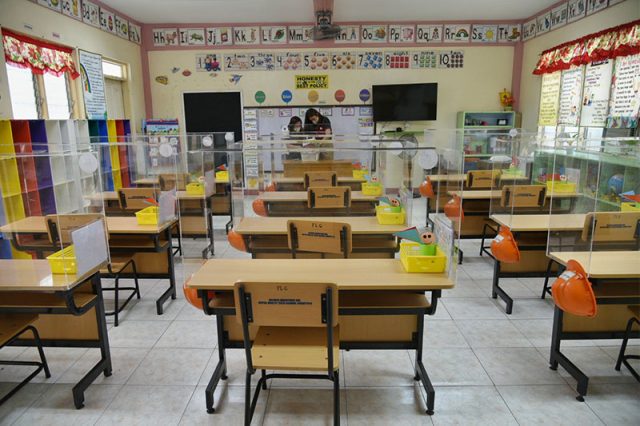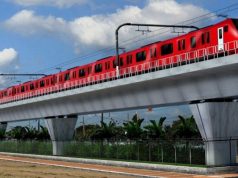
Ventilation and good airflow were pushed after Manila Mayor Isko Moreno Domagoso showed pictures of an elementary classroom with desk barriers and helmets in preparation for pilot implementation of face-to-face classes.
The city chief on his Twitter account on Tuesday shared how the Aurora Quezon Elementary School in Malate is preparing for the resumption of non-virtual faces a year after blended learning was implemented by the government.
Each desk, including the teacher’s, has a transparent barrier across the seat. There are also helmets for each student.
“Sa mga nanay at tatay ng mga Batang Maynila, naggagayak na ang inyong Division of City Schools thru Dr. Magdalena Lim at ang inyong pamahalaang lungsod,” Domagoso said.
“Naglalagay na tayo ng acrylic barriers para pumanatag kayo na pagbalik ng mga anak niyo may mga ginawa na ang pamahalaan para maingatan sila. So kapit lang,” he added.
According to the Manila Public Information Office, the Aurora Quezon Elementary School is among those chosen to be part of the potential pilot implementation of physical classes.
“We would like to be ahead of the situation para if maghanap ang DepEd ng pwedeng pagsimulan ng limited face-to-face classes sa Manila, we will volunteer na ‘yung school since we are ready. Use of school is still subject to the approval of DepEd Central Office,” the Manila PIO said.
The Philippine News Agency reported that 12 kindergarten students and 16 students from Grades 1 to 3 will be allowed inside the classrooms once it earns approval from the Department of Education.
DepEd’s Memorandum No. 71 (series of 2021) states that public schools must conduct the School Safety Assessment Tool to determine their readiness.
Dr. Magdalena Lim, superintendent of Manila’s Division of City Schools, and Armand Andres of the Department of Engineering and Public Works, led the ocular inspection of the Aurora Quezon Elementary School.
“We placed protective shields tsaka ‘yung mga protocols (and as part of protocols), alcohols and thermometers,” she said in an interview.
The Manila PIO said that the precautionary measures will still have to undergo approval.
“For clarification, hindi pa po ito approved ng Central Office since these will still undergo pa ng safety seals certification,” it said.
Apart from Aurora Quezon Elementary School, others included in the city’s list for possible face-to-face classes are Hizon Elementary School, Burgos Elementary School, Pio del Pilar Elementary School, Avancena High School and I. Villamor Senior High School.
‘COVID-19 is airborne’
Those who saw Domagoso’s post reminded him that the virus causing COVID-19 is airborne amid the installation of desk barriers in the classroom.
“Mayor, sayang po ang gastos sa plexiglass niyo. COVID is airborne. Sana po maganda ang ventilation sa mga classroom at hindi din madami ang teacher: student ratio. Para saan po ang helmet?” a Twitter user claiming to be a pediatrician commented.
“Airborne ang transmission ng virus, hindi droplets, kaya ‘di kailangan ang acrylic dividers. ‘Yan ang katumbas ng face shield na ayaw ninyo ‘di ba!? Proper ventilation ang kailangan!” another online user said.
“Mas ok kung buksan na lang ‘yung windows on each side, get additional fans. The acrylic shields and lol (laugh out loud) the hard hats are just for optics but they offer no protection. Impedes air circulation, and provides additional distractions to learning #covidisairborne,” another Twitter user said.
A different social media user likened the barrier installation to the “government requiring face shield all over again.”
“Sayang budget sa hard hat at acrylic glass when COVID is airborne. 2021 na jusq (jusko),” the Twitter user said.
A report by New York Times last August argued that plastic barriers “do little to stop the spread of the coronavirus.”
It said that under normal conditions, exhaled breath particles in classrooms, stores and offices disperse, get carried by air currents and then get replaced by fresh air around every 15-20 minutes, depending on the ventilation system.
The report said that installing plastic barriers can change the air flow in a room, disrupt normal ventilation and create “dead zones” where viral aerosol particles can build up and become highly concentrated.
“If you have a forest of barriers in a classroom, it’s going to interfere with proper ventilation of that room,” Linsey Marr, professor of civil and environmental engineering at Virginia Tech, was quoted as saying.
“Everybody’s aerosols are going to be trapped and stuck there and building up, and they will end up spreading beyond your own desk,” she said.
The report also cited a study led by John Hopkins researchers last June which showed that desk screens in classrooms were associated with an increased risk of COVID-19 infection.
It additionally cited a research in a Massachusetts school district that found out plexiglass dividers with side walls in an office impeded air flow.
Another study done in schools in Georgia noted that desk barriers had little effect in preventing the spread of the virus compared to ventilation improvements and requiring face masks.
“One way to think about plastic barriers is that they are good for blocking things like spitballs but ineffective for things like cigarette smoke,” Marr said.
“The smoke simply drifts around them, so they will give the person on the other side a little more time before being exposed to the smoke. Meanwhile, people on the same side with the smoker will be exposed to more smoke, since the barriers trap it on that side until it has a chance to mix throughout the space,” she added.









